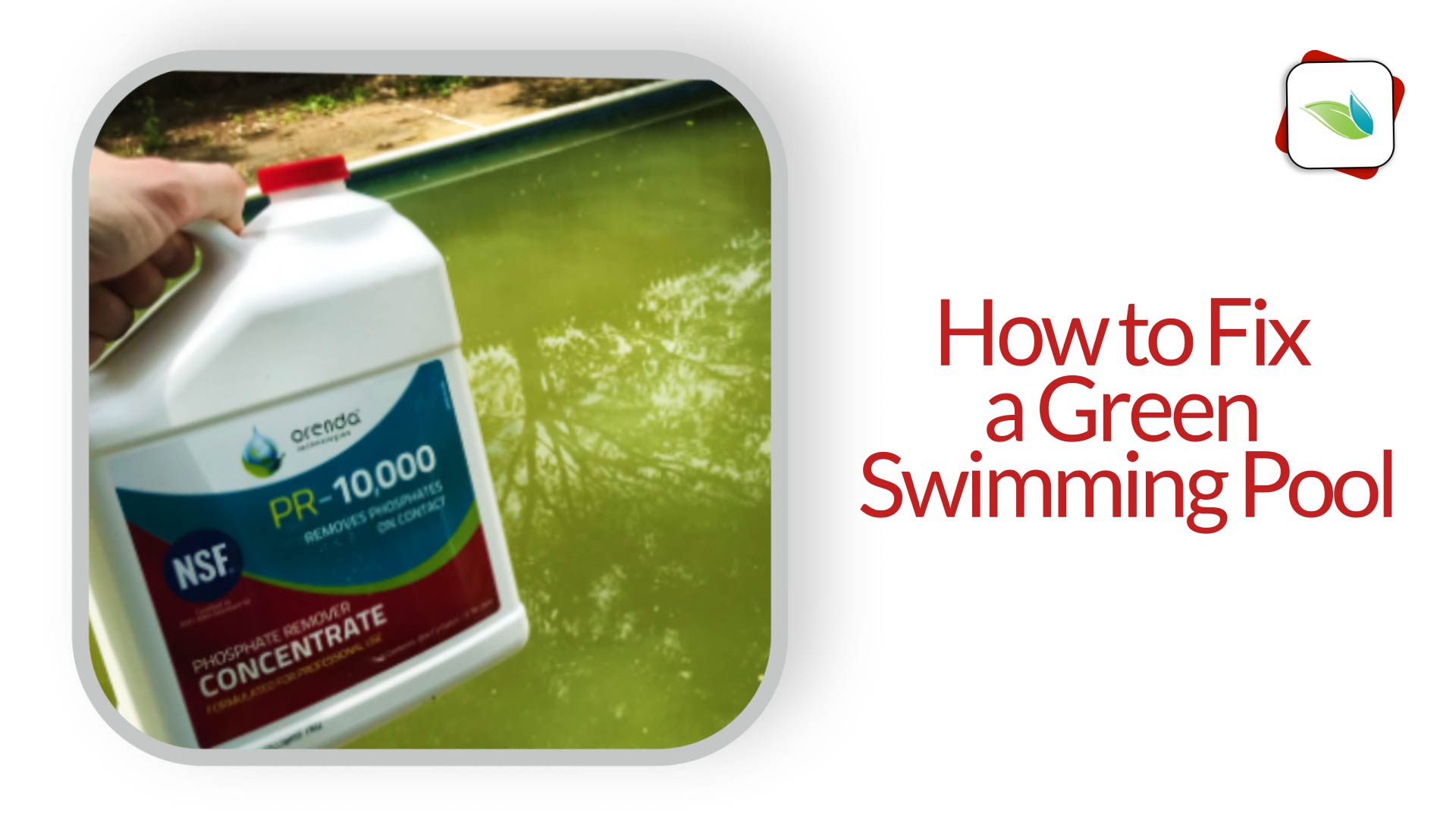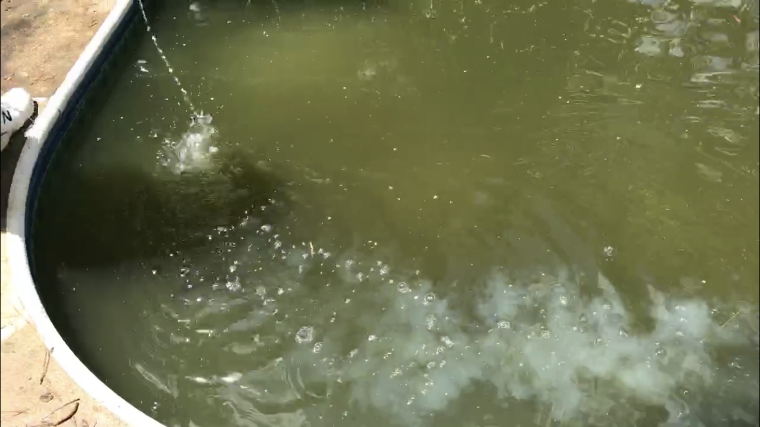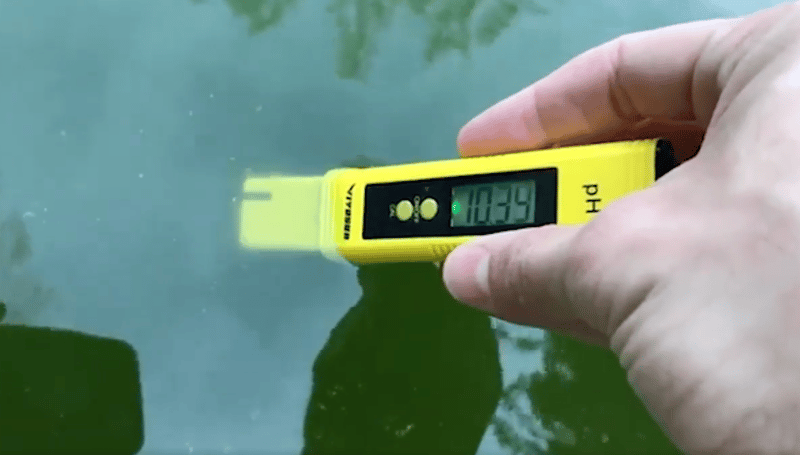Green Pool Cleanup

The Orenda Green Pool Cleanup
Based on 10,000 gallons (37,855 Liters)
Relevant episode from our podcast "Rule Your Pool" available in all mobile audio platforms.
Overview
Before conducting this procedure, are you sure your pool is green from algae? It could be copper or an imbalance of too much alkalinity relative to calcium hardness. We strongly advise you to diagnose the problem before prescribing, using a simple 30-second test called the white bucket test.
Normally, when a pool turns completely green from algae, it has been neglected for several weeks or more. There are usually leaves and other debris piled up in it, and the pool flipped because the pool became eutrophied. Algae take over a pool when its growth/reproduction rate exceeds the killing rate of the sanitizer (chlorine). You can kill algae with chlorine and algaecide all you want, but unless you address the source of the problem, you could face algae again in the near future. And be aware that most algaecides leave behind byproducts that chlorine will oxidize, so for this procedure, non-stabilized chlorine is the only algaecide used.
The Orenda Green Pool Cleanup procedure is our method of clearing a green pool efficiently. This procedure is a chemical 1-2-3 punch of non-stabilized chlorine to kill algae, PR-10,000 to remove phosphates, and CV-600 or CV-700 enzymes to handle the non-living organics.
Related: How to Implement the Orenda Program
You will need:
- A reliable test kit with an acid demand test.
- Muriatic acid, a clean bucket, a measuring cup, and safety gloves/glasses.
- A pool brush, net, and vacuum.
- Non-stabilized chlorine (liquid sodium hypochlorite, or cal hypo granular shock).
- Purge dose (32 fl.oz./10,000 gallons) of PR-10,000 phosphate remover.
- Purge dose (32 fl.oz./10,000 gallons) of CV-600 or CV-700 enzymes.
Day 1
- Clean out as much debris and dirt as possible with a net and vacuum. Do not shortcut this step! Piles of leaves and debris will protect algae from chlorine and this procedure may not work as well as it should.
- Brush the pool thoroughly. Do not skip this step either!1
- Lower pH to about 7.5 with pre-diluted acid around the perimeter of the pool.2
- The pH of a green pool can be very high. We have measured it over 10.3 before. See footnotes below.
- Raise chlorine up to 10-20 ppm using non-stabilized chlorine (liquid chlorine or cal hypo shock) Liquid chlorine is preferred for easier and faster use, as cal hypo needs to be pre-dissolved in buckets before adding. Add the entire chlorine dose around the perimeter.
- Add 32 oz. of PR-10,000 phosphate remover for every 10,000 gallons of water around the perimeter of the pool.3 This full dose of PR-10,000 is also called the "green pool cleanup" dose on the dosing results page as shown in the Orenda Calculator™:
.gif?width=736&height=414&name=Orenda%20app%20on%20phone%20(ENGLISH).gif)

- Purge with CV-600 or CV-700 enzymes (32 fl.oz./10,000 gal) around the perimeter of the pool or into the skimmer or gutter (if you choose to circulate, rather than shut the pump off).
- Deciding whether or not to run circulation depends on your filter type and the severity of the problem. We recommend pools with D.E. filters shut off circulation for at least several hours (preferably overnight) after doing steps 3-6. The pressure could build too much and damage the filter grids.
- If you choose to run circulation with a sand or cartridge filter, you will likely need to clean/backwash the filter more than once.
Explanation
Remove debris and brush the walls and floor to stir everything up. Lowering pH allows for more optimal chlorination (see footnote 1 below), and chemical efficiency is key to this process. The full purge of PR-10,000 eliminates phosphates on contact, which will floc to the bottom. CV-600/700 enzymes break down and remove non-living organics and oils, which there is an abundance of in a green pool. Removing the organics helps the PR-10,000 fallout fall to the floor, rather than being stuck in suspension (sinking dust can get stuck to rising oils and organics).
Day 2
The water should have mostly cleared up and you should see white dust and debris on the bottom of the pool. If the water is still cloudy, consider these troubleshooting options:
- If the cloudiness is light/white/gray colored, it could be calcium precipitating because the pH was not lowered enough. Do an acid demand test to lower pH to 7.5, pre-dilute the required acid, and pour around the perimeter of the pool.
- If the cloudiness is green/brown/murky, there is probably debris that has protected algae in the depths of the pool, and Step 1 on Day 1 was not as thorough as it needed to be. Clean more debris out and repeat the Day 1 process.
If the water has mostly cleared, as expected, proceed with the following steps:
- Thoroughly vacuum the pool (to waste) and skim off any leaves or debris.
- If your vacuum system runs through your pump and filter, find a way to bypass the filter (at a minimum). If this is not possible, hire a pool professional who has a vacuum system they can bring to your pool to handle this. The debris pulled out can clog up your pump and strainer basket quickly.
- Clean the filter(s). For sand filters, backwash and rinse thoroughly. Consider a filter purge if needed.
- Test the free chlorine level. If you have below 5 ppm FAC, increase chlorine to 5 ppm.
- Adjust the pH and/or alkalinity to achieve LSI balance. The pH will naturally rise, so if you have too low of a pH, let it rise on its own and focus on alkalinity.
Follow Up and Weekly Maintenance
- Perform necessary vacuuming and brushing
- Backwash and/or clean filter as needed
- Make any necessary chemical adjustments
- To be proactive in preventing algae in the future, avoid CYA over-stabilization so that chlorine's killing rate is optimal (Pillar 4), and address the oxidant demand from nonliving organics (Pillar 2). Remove phosphates regularly to keep phosphates to a minimum, ideally below 500 ppb (Pillar 3).
- To be proactive in preventing algae in the future, avoid CYA over-stabilization so that chlorine's killing rate is optimal (Pillar 4), and address the oxidant demand from nonliving organics (Pillar 2). Remove phosphates regularly to keep phosphates to a minimum, ideally below 500 ppb (Pillar 3).
More Questions?
866-763-4269
1 During a Facebook Live broadcast of a green pool cleanup, Eric from Orenda was distracted by speaking to the audience, and forgot to brush the pool to stir everything up. The consequence was an additional 4 days for the pool to settle out and clean up. While the pool turned blue, it remained cloudy for four whole days instead of just 24-36 hours like normal. The lesson here: do not shortcut removal of leaves and debris, and always brush the pool thoroughly to stir everything up. You want chlorine to reach everything. Piles of leaves can protect algae from chlorine.
2 The pH of a green pool is usually very high due to algae's consumption of CO2. If there is CYA in the pool, pH does not really control the strength of chlorine, and chlorine almost instantaneously binds to CYA. For a green pool, we want the chlorine level to be 10-15 ppm, and we want chlorine to work as efficiently and as fast as possible. The other reason for dropping pH prior to chlorine shocking is because hypochlorite chlorines (liquid and cal hypo) have a high pH as it is. When they are added to water, they will create a high-LSI violation locally, and calcium carbonate will precipitate and cloud the water. In the case of cal hypo, the calcium will separate from the chlorine and stay near the surface, turning the water white. We learned this the hard way. The bottom line: Lower pH before shocking.
3 Note: This PR-10,000 purge dose is 4x more than the normal PR-10,000 purge dose. Do not swim until the pool is clear enough to see the main drain at the bottom.
